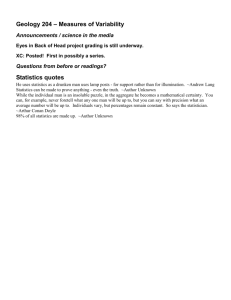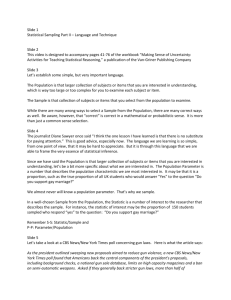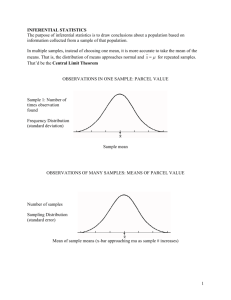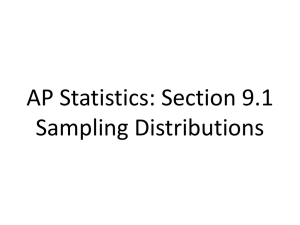day6 - University of South Carolina
advertisement
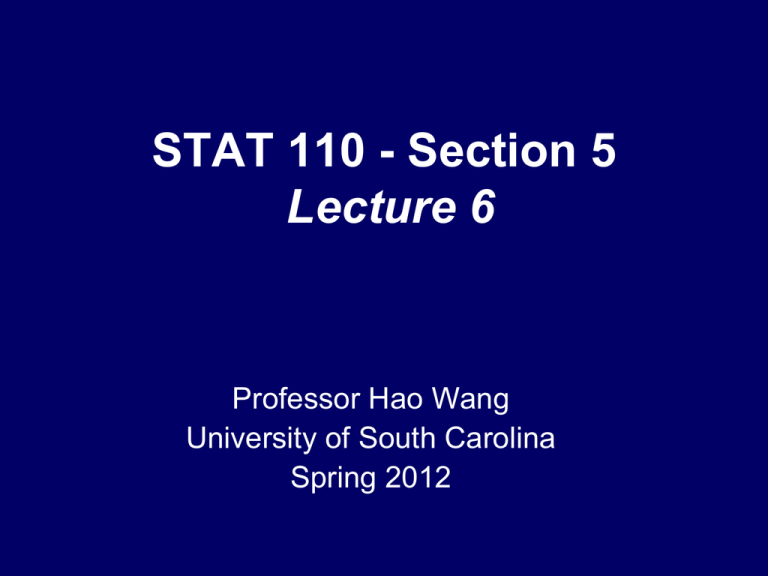
STAT 110 - Section 5 Lecture 6 Professor Hao Wang University of South Carolina Spring 2012 Last time Population and Sample (II) Sample variability Example How many hours of sleep does an average USC undergrad have ? Ask your 2 neighbors and average their answers. A B C D E less than 5 hrs 5-6 7-8 9-10 more than 10 hrs Population ? Parameter ? Sample ? Statistic ? Example How many hours of sleep does an average USC undergrad have ? Ask your 5 neighbors and average their answers. A B C D E less than 5 hrs 5-6 7-8 9-10 more than 10 hrs Population ? Parameter ? Sample ? Statistic ? Sampling Variability bias – consistent, repeated deviation of the sample statistic from the population parameter in the same direction when we take many samples systematically misses in the same direction variability – describes how spread out the values of the sample statistic are when we take many samples. amount of scattering Picturing Bias and Variability Variability of 1,000 of size n = 100 Variability of 1,000 of size n = 1,523 Notice that with larger samples (1523 vs. 100), there is a lot less variability….but the distribution is still centered at p = 0.60 (so p-hat is unbiased for p) Example: 2012 Florida Republican Primary http://www.rasmussenreports.com/public_con tent/politics/elections/election_2012/election _2012_presidential_election/florida/2012_flo rida_republican_primary 10 In the previous poll: A – The population is the 750 voters B – The population is all likely Florida voters In the previous poll: A – The percent of all likely FL voters favoring Gingrich is the Parameter and the 41% of the 750 is the statistic B – The percent of all likely FL voters favoring Gingrich is the statistic and the 41% of the 750 is the parameter In the previous poll: A – The variability is because Gingrich has been in the news a lot recently, and the bias is because it was a random sample. B – The variability is because it was a random sample, and the bias is because Gingrich has been in the news a lot recently. (III) Margin of Error Margin of Error During the week of 8/10/01, CNN conducted a poll asking an SRS of 1000 Americans whether they approve of President Bush's performance as President. The approval rating was 57% (plus or minus 3%). In their next poll conducted during the week of 9/21/01, CNN conducted the same poll asking an SRS of 1000 Americans whether they approve of President Bush's performance as President. The approval rating was 90% (plus or minus 3%). Why the difference in ratings? Where does plus or minus 3% come from? Margin of Error The margin of error (MOE) is a value that quantifies the uncertainty in our estimate. When using the sample proportion to estimate the population proportion, the MOE is a measure of how close we believe the sample proportion is to the population proportion. Calculating Margin of Error Use the sample proportion from a SRS of size n to estimate an unknown population proportion p. For 95% confidence (the quick formula): Example: Margin of Error The CNN Poll interviewed 1000 people. What is the margin of error for 95% confidence (using the quick formula)? Answer: Recall 95% confidence Example: Margin of Error If the sample size is 100, what is the margin of error for 95% confidence (using the quick formula)? A.0.10% B.0.01% C.10%
